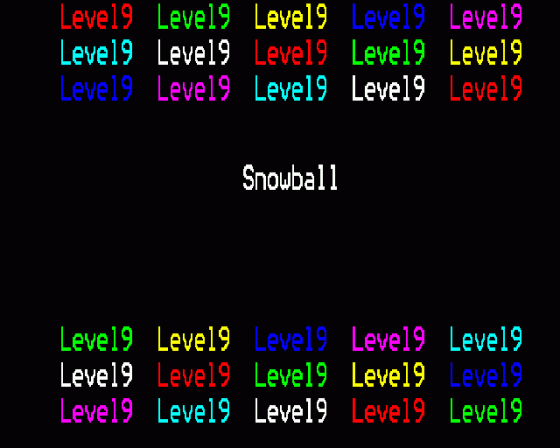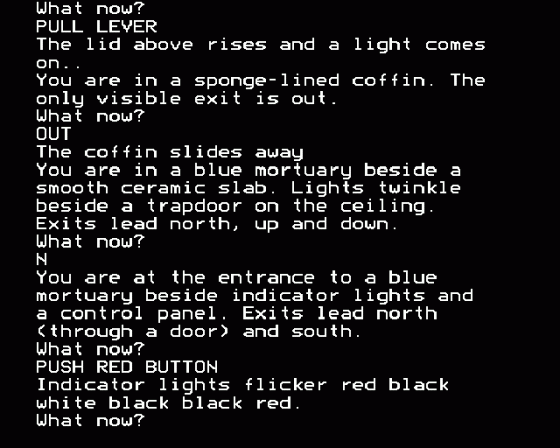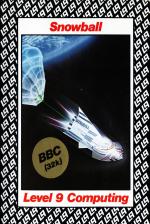




| Genre: | Adventure Game: Text-Only |
| Publisher: | Level 9 Computing |
| Cover Art Language: | English |
| Machine Compatibility: | BBC Model B |
| Release: | Professionally released on Cassette |
| Available For: | Amiga 500, Amstrad CPC464, Atari 400/800/600XL/800XL/130XE, Atari ST, BBC Model B, Commodore 64, Oric 48K & Spectrum 48K/128K |
| Compatible Emulators: | BeebEm (PC (Windows)) PcBBC (PC (MS-DOS)) Model B Emulator (PC (Windows)) |
| Original Release Date: | 1st January 1984 |
| Original Release Price: | £12.99 |
| Market Valuation: | £2.50 (How Is This Calculated?) |
| Item Weight: | 64g |
| Box Type: | Bubble Clamshell single/double cassette black |
| Author(s): | Mike Austin, Nick Austin & Pete Austin |
Variant Items
There are 2 other items featuring this same game (that we know about!). Click any of them for their details.
Active Auctions
Closed Auctions
Buy It
Unfortunately no-one is currently selling this item.
Auction Price Watch
Worried you're being ripped off? Closing prices on eBay can help you decide what a reasonable price is for a particular item.
Components
This item originally came with the following components:
- Instruction Manual
If scans of components are available, you will find them in the Cover Art section.

A&B Computing
1st January 1984
It has taken nine months to perfect this masterpiece and I envisage taking a similar length of time to complete it. Read Review
Full Instructions
Snowball
Snowball is a big adventure game. It has over 7,000 locations and has taken nine months to produce. It's probably unique among adventures in having a realistic, planned background and being set aboard a starship that could actually work.
You play Kim Kimberley, secret agent extraordinary.
Your mission: to safeguard the interstar transport, Snowball 9, as a last resort following catastrophic accident or sabotage.
Thus, when your modified freezer-coffin wakes you with the Snowball still in transit, you know that something must be very wrong. You're weakened and disorientated from lengthy hibernation, but the fate of two million passengers is in your hands!
Background
Snowball 9 started its journey to the stars from the EEC's Ceres base, one of fifty colony starships launched in the 2190s. It carried the first colonists for Eridani A.
First to be despatched were the ten giant passenger disks, rotating ponderously to provide internal gravity. Each was towed gently by a cluster of small tugs and floated into the void with 200,000 sleeping colonists on board.
Then the Snowball's engine unit followed, accelerated rapidly by the spectacular flares from its four great fusion motors. Like previous launches, and the link-up with the disks some weeks later, this was holo'd worldwide... though few people bothered to watch.
Looking like a necklace of sparkling beads, Snowball 9 headed out into deepest space, and into a century of obscurity.
But the major part of the launch was yet to come. And it happened quietly, out of the glare of publicity. The chains of accelerators, beyond Pluto, burst erratically into life throughout the following three years; firing ten-tonne blocks of ammonia-ice at precise speeds after the receding craft. Once reeled in by the Snowball's skyhooks, the ice was built into a huge hollow shell around the linked passenger disks. When complete, this shielded the disks during the voyage; until the ice was finally needed as fuel for the ravening fusion drives.
The ice-shell, which gave the Snowball series its name, formed most of the mass of the completed craft. And without the accelerator/skyhook system of "in-flight refuelling", realistic-time interstar voyages would not have been feasible.
As with life, the first thirty years of Snowball 9's journey were the most interesting. The computers and crew had to catch as much ice as possible before it flew past. But even then there were never more than six active crew at a time.
Then the starship was left to coast until its destination was near, the crew hibernating with the passengers. A brief flurry of activity to start deceleration, and back to autopilot. Even allowing for the great resilience, and hence low sophistication, of the Snowball's machine intelligences, they are quite capable of running everything unaided. No further crew members were woken until a year from journey's end.
The plan from here on was to continue deceleration, shed the remains of the ice-shield (by now eaten away to insubstantiality by the needs for fuel), and dock with the target planet, Eden, in geostationary orbit. Finally the passengers would land by glider-shuttle, a process taking many years to get everybody down, and necessitating the retrieval of grounded gliders by sky hook: the same gliders being used many times.
This was the plan, anyway.
Meanwhile in the Eridani star system, the robot descendants of the original survey craft that scouted Eden have been hard at work. The original crude waldroids, directly controlled from the survey craft's computers, were good for little other than routine manual work. But they have long been superceded by a host of specialised robots: highly intelligent and suitable for any task.
Indeed, in the outer reaches of the planetary system the first accelerator chains are already being built. It will not be long before colonists can leave Eden for remoter stars.
The colonists have taken over a hundred years to reach Eden, but the robots can obtain information and programming at light speed. They are immeasurably ahead of their future 'masters' in knowledge and technology. Even if Snowball 9 arrives safely, it is by no means certain that the passengers will be able to cope with the sudden outdating of all their experience.
The physical well being of the colonists is, however, assured by the robot's diligent work. Condos, paveways, PVTs, holo nets, pre-ordained work, everything necessary for civilised life will be provided. After all, why risk further disruption of the social fabric resulting from a manifestation of the so-called "pioneer spirit"?
All you, as Kim Kimberley, have to do is rescue the Snowball 9. The task of helping the colonists cope with the city that the robots have built can be tackled in the sequel to this adventure: Return To Eden. Neither will be easy!
Kim Kimberley
Kim is 1.7 metres tall, weighs 55 kilos, is fairly intelligent, athletic and has brown eyes and fair hair. Now aged 22, or 25, or 131 years... depending on how you calculate these things.
Born on September 29th 2172 AD, of Jorel Cowans and Alice Kimberley, Kim was raised by the Hampstead Creche. This was a peculiar place, set amongst decaying buildings, and heavily reliant on a mix of relationship-engineering, behaviour conditioning and Hell-Fire religion. It was finally closed in 2185 for breaches of the Android Protection Acts. It seems to have done Kim little harm however, though possibly contributing to a tendency towards introversion.
Then to the Milton Keynes School of Life: a fine, residential establishment situated (despite its name) in Malta. The staff were, in effect, Kim's family. (This type of situation by the way, was far from unusual in the late 22nd century. Advances in entertainment and travel, plus the sexual revolution resulting from AI, partho and cloning techniques, made a family up-bringing the exception.)
Kim returned to England for National Service before progressing to Oxford (being not quite bright enough for Cambridge). Kim proved a good student, and established many close relationships, though nothing permanent.
It was during National Service that the event central to the Snowball mission took place, though it went unremarked at the time. Kim was approached, discretely, to do security work. Initially this simply involved training, and occasional surveillance of possible subversives (Unionists, Americans, members of racial minorities, etc) but it soon developed into counter-espionage (e.g. arrested Russians who used the public reference libraries).
And then, when the Snowball project got underway, Kim was approached to volunteer for the stars. The Snowball craft were as near automatic as possible, and carried a trained crew in case anything went wrong. But suppose something happened to the crew?
What was needed were one-or-two trained people, carried without the crew's knowledge, who could emerge and take over if somethning went really wrong. And, with the Snowball 9, it has...
The Game
Snowball is a full scale adventure game, with well over 7,000 locations, 700 messages, about 60 objects, etc, etc. You will have to solve a large number of puzzles while finding your way to the main control room in the engine unit - and saving the starship.
To play Snowball, load it from the cassette and then simply enter English phrases to tell the computer what you want to do (e.g. SEARCH THE ROOM or LOOK AT THE PANEL). The program will act as your eyes and ears to describe your surroundings.
As with all proper adventure games, Snowball is very easy to play - you don't need to be able to type rapidly, or blast aliens by reflex. But don't be too surprised if it takes weeks (or months) to complete.
The best way of playing is probably to use the program in short sessions, stopping if you seem to be totally stuck and resuming if you come up with an idea thatmight work. Making a map will probably help, though I advise against trying to show all the rooms! Remember that you can use the SAVE and RESTORE commands to save the current state of play and restart after - they are quite quick.
If you have any problems with solving the game, please use the hints card included. You're welcome to enclose it with a letter if you like, but hint-requests may well not be answered unless the card is included.
If you have any problems with using the gme program, please tell us which computer you have (and, for cassette problems, which cassette recorder you have). Please help us to help you!
Instructions
The program asks "What now?" whenever it expects you to enter another command. Simply type an English phrase to tell it what you want it to do and press RETURN (or ENTER). The program will act on your request, ask you for the next command, and so on.
The program knows an extensive vocabulary of English words (over 200) and it looks at your entered command, picking out the words it knows and 'guessing' your meaning from these. Only two or three words are used for each phrase, so you are advised to keep instructions simple.
In practice, you should find it smple to state what you want to do, but if the program does not understand, just rephrase your request.
Snowball provides great freedom in possible commands but, to help you get started, some possible instructions are summarised below:
INVENTORY
LOOK AT COFFIN
EXAMINE COFFIN
NORTHWEST
TAKE SPANNER
WEAR HELMET
DROP THE RED FORM
SEARCH THE ROOM
PUSH THE GREEN BUTTON
LOOK AROUND
GIVE DRINK TO ROBOT
OPEN DOOR
WHAT'S MY SCORE
CUT TUBE WITH SCALPEL
These are only a small sample of the words known by the program. To save typing, words can be abbreviated (e.g. EAST to E, NORTHEAST TO NE, and AGAIN to A).
The command analyser used by Snowball is even cleverer than that used in our "Middle Earth" trilogy of games. For example:
- Word order is less important. For example GIVE THE ROBOT A DRINK is the same as GIVE A DRINK TO THE ROBOT.
- You can take or drop EVERYTHING
- As well as compass directions for movement, LEFT, RIGHT, FORWARDS and BACKWARDS are allowed.
- AGAIN repeats the previous command.
- Snowball understands IT, and IT can save you time. Use IT if you want to act on the same object as in your last command - but please keep IT simple.
You should know three special commands:
QUIT
Abandon the game. You can start again if you like.
SAVE
Keep the current state-of-play on tape. Start your recorder on RECORD, with a blank tape, first.
RESTORE
Load a SAVEd position back from tape.
Scoring
There are no "treasures" in Snowball: you don't score points for finding things and storing them away as in many games.
Instead, points are scored for doing things that are steps on the way to the eventual goal for getting to the main control room and rescuing the starship from its fate.
For example, you need to get out of the freezer coffin, where you are at the start of the game, and subsequently need to assemble a working space-suit. Both these activities score points.
On the debit side, if you're caught by the Nightingales you lose points. And if you manage to get killed, you lose more.
Hints
Buyers are entitled to a free clue each, and a hints card is enclosed for this. Put it in an envelope, with another stamped, self-addressed envelope, and send it to the address at the back of the instruction booklet. We will do our best to reply as quickly as possible. Don't use up the clue too soon!
Answers will be truthful, but partial answers may be given to questions which take too much work. (e.g. "Please list all words understood by the program" or "What are the functions of all the objects?") We'll try to be fair and help you to progress.
- Everything in Snowball has a purpose.
- Remember that the adventure is set in the starship described in this booklet. It is logically designed and there is no "magic". However, some of the technology used might be described as magical in 1980's terms.
- North means towards the front of the starship and the other "compass" directions are relative to this. Up and down, on the other hand, are determined by local "gravity".
- At the start of the game, you are in the lowest level of a passenger disk. You need to go "up".
Terran Expansionary Phase, 2120-2210
The late 21st Century saw a great increase in space travel within the solar system.
Fusion power was not yet feasible, conventional fuel sources were close to running out, and the energy needs of the industrial nations were ever-increasing. The solution lay in space. Solar reflectors, if made large enough, could easily concentrate any amount of energy... and beaming it back to Earth was simplicity itself.
What was not simple was to transport enough material for thousand-mile reflectors into space. Indeed, it was much more efficient to use what was already there... and thus the first accelerator chains were set up to boost asteroid material from beyond Mars into Earth orbit.
By 2120, thirty perent of Earth's energy came from the space reflectors and the proportion was steadily rising. And, to supply the colossal requirements of the orbital industries, the whole Solar System was linked by accelerators.
Then workable fusion power was perfected. And it was *very* cheap.
The whole space sector of the economy was redundant. And a lot of politicians risked looked very silly indeed.
Thus, a use for the accelerators, space reflectors and orbiting factories had to be found... and Stellar Colonisation was it. A lot of voters/party members read SF, after all. And colonies are always popular (at first, anyway).
So the accelerators were linked up and fired out of tens of thousands of small exploration probes in all directions. these robots would coast through space with only one mission - as each flashed past a star it would report back the existence of Earth-sized planets. Unmanned, they could continue for centuries.
Ten years behind came larger survey craft, each clutching a great ball of ammonia ice to power its fusion motor. If one was lucky enough to be following a successful exploration probe, it had just enough time to decelerate (from its coasting speed of 0.3 degrees C) before reaching the star. Once there it would scout the system and, if there really were habitable plants (or even ones requiring controlled climate domes as long as the ground was solid) it would radio the information back to Earth.
Then, while waiting for the first colonists to join it, decades later, the survey craft would proceed to prepare a world for them to live in.
First came a long, slow, painstaking period of asteroid mining - assembling the necessary materials to build its first robot-production line. The first robot would take ten or twenty years, the next ten or twenty days and the thousandth would take minutes.
By a process of careful boot-strapping, highly-intelligent space factories were built... and colossal dish receivers to collect the constant stream of technological data from Earth.
Next came the landings on the target planet, city building and making ready for the colonists. And, at the same time, preparations for launching more probes and survey craft.
The Terran Expansionary phase was scaled down as time passed, and eventually stopped - as far as Earth was concerned. Domestic political pressures changed, and politicians became more concerned with the quality of life for the so-called Free Nations than with space exploration. But the starships were in flight, and the foundation of the Human Empire was assured.
Geopolitical Summary, 2195
To generalise: nations can be divided into two groups, the Big 5 superpowers, and the Free Nations.
The Big 5 (China, EEC, Pacific, US Empire and USSR) are fully urbanised, dependent on sophisticated technology, and despite their much-publicised feuding they have reached de-facto compromises nor dictatorships. Most of their populations live in luxury (though the man-in-the-street would never admit this).
The Free Nations are, in effect, the former Third World. No significant improvements have taken place in living standards or technological infrastructure, though populations are higher than ever before. Communications are excellent, however. The people know that they are kept in poverty and resent the fact, and ironically this is a major reason for the Free Nations' poor development performance. Other reasons are: proxy wars, wealth disparity combined with ready supplies of weapons, poor infrastructure, reduced world market share due to automation elsewhere, excess imports to ruling cliques, skilldrain, population growth, endemic disease and climatic instability.
In the near future the Big 5 will finally decide to help the Free Nations, but in the 2190s they are chasing stars.
England, Kim's "birth" place, is a minor part of the EEC. Very prosperous, 50% built-up and with a population of 70 million.
To the evident astonishment of its citizens, who consider it a most boring place, the major industry is tourism. In summer, you can't move in London for the waldroids shuffling around: foreigners soaking in the sights through every gleaming lens.
The biggest employer of labour, however, is the Experience Industry. The Dream Palace of Wigan and Reveline of Bucks churn out epic "adventure games" for the enjoyment of billions worldwide - and for the 30 million unemployed at home.
Housing is good, robot slaves are plentiful, and most people are quietly happy in the belief that their country is best.
Implementation
Snowball is written in Level 9's own super-compact adventure language known as 'a-code'. This gives machine-code speeds and is much smaller. Additionally, text messages have been compressed to about half size (by the automatic extraction of the most common strings - such as "the" - and their replacement by single characters). Additionally, the coding is rather cunning in places too.
Thus the game needs much less space than it ordinarily would - and we can cram in much more detail than other companies do!
Loading
Tape: CHAIN"" (RETURN)
Disc: Hold SHIFT and tab BREAK to load.
Game Credits
Game Design: Pete Austin
Implementation: Pete Austin
Transport to your Computer: Mike Austin
A-code Compiler and System: Mike Austin
Data Compiler: Pete Austin
Additional Expertise: Ian Buxton
Instruction Booklet: Pete Austin
Artwork: Tim Noyce and Pete Sherwood
Typesetting etc: Crowley Graphics
Miss Kimberley's Costume: Spider & Jeanne Robinson (Stardance)
Inspiration (in part): Larry Niven and Jerry Pournelle (The Mote in God's Eye)
Miscellaneous
This game was mentioned in the following articles:
Screen Designers
The following utilities are also available to allow you to edit the supplied screens of this game:
Cheats
Download
A digital version of this item can be downloaded right here at Everygamegoing (All our downloads are in .zip format).
| Download | What It Contains |
|---|---|
| A digital version of Snowball suitable for BeebEm (PC (Windows)), PcBBC (PC (MS-DOS)), Model B Emulator (PC (Windows)) |
Report A Problem
We thank you from the bottom of our hearts if you report something wrong on our site. It's the only way we can fix any problems!
You are not currently logged in so your report will be anonymous.
Add Note
Release Country
Change the country to update it. Click outside of this pop-up to cancel.
Scan Of Selected Article
If you auction an item, it will no longer show in the regular shop section of the site.

















